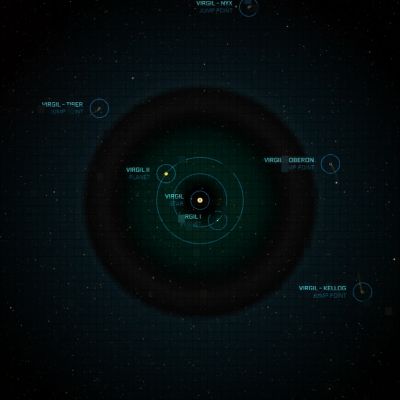 | ||
| Virgil system | ||
|---|---|---|
| System Type | Single Star | |
| Size | 16 AU | |
| Star Type | Main Sequence-Dwarf-K | |
| Asteroid Belts | 1 | |
| Affiliation | Vanduul | |
| Discovered in | 2412 | |
| Discovered by | Alaine Viktus | |
| Planets | 3 | |
| Jump Points | 5 | |
The Virgil system was once a shining star of Humanity's expansion, the system's main economic and social hub was Virgil I, which was quickly terraformed and colonized with help from the government-funded Project FarStar. After Tiber fell, the UEE military hastily retreated into Virgil and tried to mount a defense to stop the Vanduul advance, but the unrelenting raiders quickly overwhelmed them. Millions of civilians died as the UEE fled the system; leaving it in the hands of the Vanduul ever since.[1]
History
The Virgil System was discovered entirely by chance in 2412. Famed astrophotographer Alaine Viktus was conducting a deep field survey roughly half an astronomical unit past the Vega system's cometary cloud. Viktus had powered down his survey runabout's thrusters and 'gone dark' to capture a maximum scan resolution. Upon attempting to activate his highly specialized stellar camera, he found it unable to star-lock because of an imperceptible level of spacecraft movement. Further investigation revealed the movement, mere microns from what his IFCS had calculated as standstill, was the result of extreme proximity — within 400 meters — of an uncharted jump point. General amazement over Viktus' incredible luck quickly turned to an unequaled passion for expanded space exploration. The K-type main sequence star, quickly named Virgil by Earth spin doctors seeking to instill a sense of regal manifest destiny, was located in a region of space previously thought naturally inaccessible. What's more, its first planet was the single strongest candidate for terraformation yet discovered. Within ten years, Virgil was a verdant, thriving Human colony and inside of a century it was considered a surefire choice for formal UPE representation. The rapid colonization of Virgil lead to Project: Far Star, the government-funded march 'outward' into the area of space now unlocked with Virgil's discovery. Then, as rapidly as it began, the situation reversed. The discovery of the Vanduul in 2681 and the onslaught of their increasingly devastating raids brought Far Star and westward galactic expansion to a full stop. Humanity was shocked by the complete fall (and subsequent UEE abandonment) of Orion. Virgil changed into a military outpost overnight, with entire fleets now operating out of the formerly quiet colony. A single jump away from Tiber, where the Empire now hoped to hold the line, Virgil's fields were adapted to support a massive military buildup. When Tiber fell, the Navy collapsed in full retreat and was unable to organize a secondary line as the Vanduul pushed relentlessly forward. The Vanduul showed no mercy to the system, slaughtering military personnel and civilians wholesale. Virgil I's idyllic biosphere was reduced to permanent clouds of ash, and some two hundred years of Human expansion were erased from history. Several transports escaped the carnage, protected by interceptors from the famed Squadron 214. Given the chance to escape the system with the transports they had saved, every member of the squadron chose to return to Virgil I and attempt rescue of more civilians. In the ensuing years, Virgil had been visited by a number of Reconnaissance in Force missions until a network of surveillance buoys were covertly established by the Empire in 2790 to provide early warning of Vanduul clans entering the system.[1]
Gravitational governors
Virgil
Virgil is a Main Sequence Dwarf-K star.
Planets
Virgil I
A terraformed world with beautiful swaths of tropical forests and soil that could quickly grow food. It was a major agricultural producer and vacation hotspot before the Vanduul attacked. These days, extensive bombing raids have left the atmosphere filled with massive clouds of swirling ash.[2]
Virgil II
A planet blanketed by thick smog that renders it uninhabitable and completely obscures views of the surface.[3]
Virgil III
A typical ice giant found in a distant orbit from the other planets.[4]
Asteroid belts
Gideon's Belt
This large asteroid belt is located between the orbits of Virgil II and Virgil III. Deposits of iron and titanium have been identified here, but never in sufficient quantities to establish mining operations during the system's Human habitation.[1][5]
Known jump points
| Jump Gate | Type | Size | Destination |
|---|---|---|---|
| Virgil - Oberon | Bidirectional | Large | Oberon system |
| Virgil - Vega | Bidirectional | Large | Vega system |
| Virgil - Tiber | Bidirectional | Large | Tiber system |
| Virgil - Nyx | Bidirectional | Medium | Nyx system |
| Virgil - Kellog | Bidirectional | Medium | Kellog system |
Gallery
References
- ↑ 1.0 1.1 1.2 Galactic Guide: Virgil System. Spectrum Dispatch - Comm-Link
- ↑ Virgil I - StarMap. Starmap
- ↑ Virgil II - StarMap. Starmap
- ↑ Virgil III - StarMap. Starmap
- ↑ Gideon's Belt - StarMap. Starmap
| Locations in the Virgil system | ||
|---|---|---|
| Stars | ||
| Planets |
Virgil I • Virgil II • Virgil III • |
|
| Moons | ||
| Asteroids | ||
| Jump Points |
Virgil - Kellog • Virgil - Nyx • Virgil - Oberon • Virgil - Tiber • Virgil - Vega • |
|
